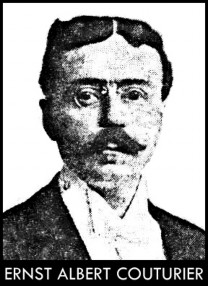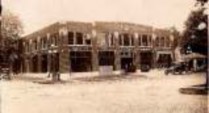
Horn-u-Copia's Display of Makers

|
118 |

|
Instruments
Couturier Instruments
Related page
Couturier on Wiki
Patents
Couturier
-
Courturier was a well known soloist at the turn of the century, though not well recorded. Between 1880 - 1902 Ernst played in many well known bands.
He first worked with Holton on the Couturier Model, then with York, and in 1918 he and others opened their own business, E. A. Couturier Co., Ltd., with the intention of building instruments using his continuous conical bore patent. Instruments of this design use a minimum of cylindrical tubing.
- 1869 Ernst Albert Couturier born in Pokeepsie, NY 1881 Couturier started to play the cornet
-
1885 Couturier entered the New England Conservatory of Music. Worked for his uncle doing watch repair in Poughkeepsie. Studied with Theodor Hoch.

- 1888 Couturier was cornet soloist at Eastman College
- 1893 Julian Jordan (Couturier"s future father-in-law) & his concert company, with Couturier on cornet, played in Mt. Vernon
- 1892 - Performed at the St. Louis Exposition. Performed on CONN Wonder Cornet, Begrudgingly relinquished this for a Conn-Queror.
- 1894 the Couturier Concert Company played in New Rochelle, NY in October; it consisted of Couturier on cornet, two singers, one piano, and violin
- 1895 Couturier and Grace Gavette performed in Glens Falls, NY; he is said to be formerly with Gilmore"s Band
- 1896 Couturier in Easton, PA in January and worked as the manager of Reigel"s piano house as well as the leader of Couturier"s Concert Band; in January he married Grace in Mt. Vernon, NY
- 1897 Couturier elected leader of Gilmore"s Band in January
- 1900 Couturier at #118 S. 7th St. in Mt. Vernon; he was the leader of Gilmore"s Band and wanted to move to New Orleans to establish a symphony orchestra there; he lived in Mt. Vernon for several years
- 1901 in Ferbruary, Couturier was cornet soloist in Philadelphia and said to be the former leader of Gilmore"s Band
- 1902 November; Couturier was the leader of the St. Louis Exposition Band; he bought the Gilmore music library ‘some time ago’ for a few hundred dollars
- 1903 in May, Couturier was the leader of the fifty piece band at Delmar Garden, the largest summer resort in St. Louis
- 1906 Couturier made a tour of Europe as cornet soloist
- 1907 Couturier worked with Holton as a consultant in cornet design and helped to produce the Couturier Model New Proportion Cornet. The Holton Couturier models were designed by Frank Holton and Couturier was the artist endorser. They were made from 1909-1912, later they made virtually the same horn as the Clark model.
- 1910 #156 S. 3rd Ave, Mt. Vernon and listed in the census as a traveling dry goods salesman
- 1911 in Chicago by December and no longer with Gilmore"s Band
- 1912 granted patent #1073593 for cornet; living in Chicago
- 1913 worked with J. W. York in Grand Rapids, Michigan
- 1914 - Produced the York Couturier Wizard Cornet, probably no later than 1915. The first really conical bore cornets made according to Couturiers 1913 patent were made by York starting in 1914.
- 1916 Couturier formed his own company with Melvin G. Lathrop, and William N. Barlow, bought out Seidel Co. in Elkhart. November 18th; articles of incorporation have recentlybeen filed at Albany by E. A. Couturier Company Ltd with $300,000 capital; #98 W. Lincoln Ave, Mt. Vernon
- 1917 stock offering advertised in April for the E. A. Couturier Co. Ltd, #149 W. 35th St., NYC or M. C. Lathrop at #98 West Lincoln Ave, Mt. Vernon
-
1918 moved to Elkhart in April; he had recently purchased the
William Seidel Band Instrument Co. of Elkhart (started in
1913);
 receives design patents for cornet & trumpet; later
this year (possibly in October) sets up his factory on the
upper floor of the Palace Garage in Laporte at the corner of
Chicago St. and the Lincoln Highway
receives design patents for cornet & trumpet; later
this year (possibly in October) sets up his factory on the
upper floor of the Palace Garage in Laporte at the corner of
Chicago St. and the Lincoln Highway
- 1919 in LaPorte; received design patent for mouthpiece; 1919 models shown at right
- 1920 at #702 Perry in LaPorte in January; musical inst. manuf.; the E. A. Couturier Band Instrument Company incorporated with $500,000 capital; directors Couturier, E. G. Greenman, & O. L. Sutherland
- 1921 in LaPorte; granted patent #1,385,202 for a trombone conical bore slide; an article called him ‘The Arpeggio King’, able to play six octaves on the cornet; he also developed an Eb cornet that would play in tune
- 1922 granted patents #1,425,318 for mute; #1,436,085 for quick change valve & #1,438,363 for valve design; music trade publications praise his high quality instruments, a new C/Bb/A trumpet designed by Couturier, a new saxophone introduced in July, & a new bell front helicon bass; Charles Newlin joined Couturier in Oct. as Sec/Tres; demand for the new saxophone by December swamps the factory, forcing a plan to double production to 1,000 per month under supervisor Otto Ziegler
- 1922 Whaley, Royce & Co. became the Couturier distributor in Canada; Fred Gretsch became distributor in eastern US
- 1923 Couturier went into receivership on October 4th; Couturier started losing his eyesight. (Some sources say Tonk bought the E.A. Couturier Band Instrument Co. from Lyon & Healy in 1923.)
- 1924 Lyon & Healy bought the Couturier company and continued producing conical bore instruments in LaPorte until 1929. The LaPorte city directory listed the Couturier Co. with F. L.Lemm manager & Otto Ziegler superintendent; bandinstrument manufacturer at #1202 Lincoln Hwy.
- 1928 in Mt. Vernon, NY in June and worked as a music teacher, #106 Haven Ave.; L&H sold the Laporte company to Holton in May
- 1929 granted patent #1,729,568 for valve design
- 1930 at #438 S. 4th Ave, Mt. Vernon; music tCouturierher
- 1940 at #438 S. 4th Ave, Mt. Vernon; music tCouturierher
- 1950 Couturier died on February 28th; listed as a graduate of the New England Conservatory of Music (Eastman), a resident of Mt. Vernon since 1928 & teacher of brass students at his home; another account says that he died in Wingdale at the Harlem Valley Psychiatric Center due to a mental breakdown
The period in time 1924-1926 is somewhat confusing in Couturier and Lyon & Healy’s history.
Couturier went into receivership in 1923 and their assets were bought by Lyon & Healy in 1924.
Lyon & Healy continued with the Couturier brass line, but with some changes made to the design (such as having normal parallel valve tubing rather than the “bowtie” valve tubing with no slides. They also put the rotary Bb/A change valve on the main tuning slide rather than back toward the piston valves where it had been).
For a short time, they seem to have used up valve blocks that had been in production, so they still have the individual patent numbers that were on the Couturier valve casings.
Even though the bells said "Couturier|Pat|Continuous Conical Bore", the saxophones made around this time (serial number) had “Lyon & Healy” as the maker and only said “Couturier Model”.
Eventually (after about serial number 31000) the brass followed suit, although they seem to have mixed the two logos for a while. Probably until they used up the old parts.
The last Couturier serial numbers were late 10,000, apparently L&H continued the series and went to about 19,000, then made some with 200 and 201,000 serial numbers.
Contribute new Data (or Corrections):
Information posted here will be added to this page.
This is not the place to ask questions, as users will only occasionally visit a particular Maker's
page. Pease use the forum to ask questions or talk about your instrument.
(Please use the forum for discussions, questions, etc.)